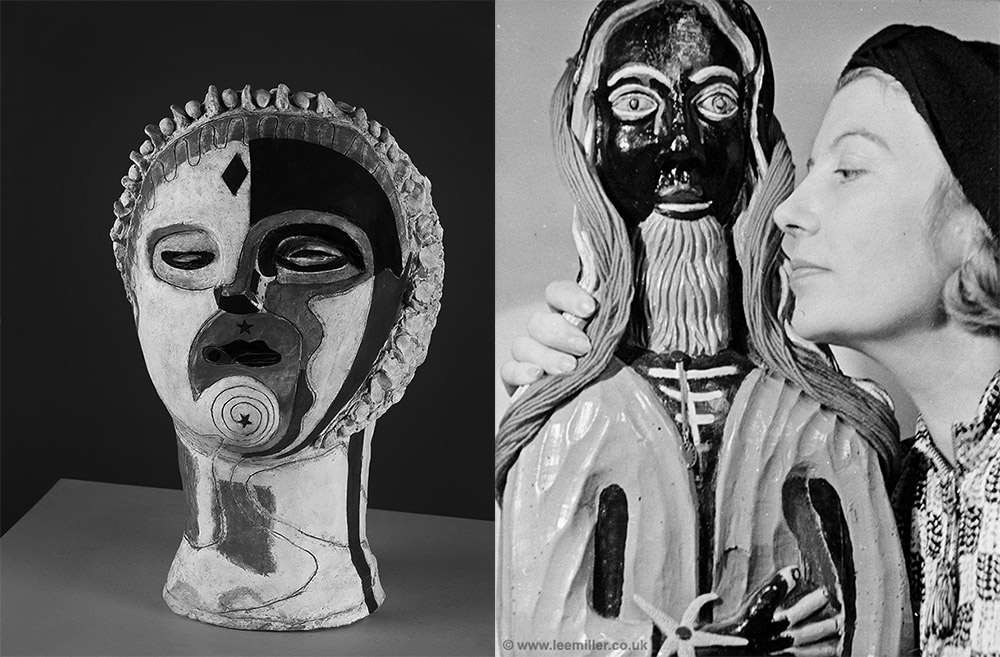PHOTO:Lee Miller and Surrealism in Britain
 Lee Miller was a model, a photographer’s assistant and then a fully-fledged photographer. In 1924 Condé Nast introduced her to the world of New York fashion, Very soon, she was the favourite of photographers, In 1929 she moved to Paris, where she became the assistant and model of Man Ray. Encouraged by his success to open her own studio, she made fashion photographs and more Surrealist-type works. In 1944, Lee Miller became an accredited correspondent with the US Army, making her the only women in combat photojournalism in Europe during the WW II.
Lee Miller was a model, a photographer’s assistant and then a fully-fledged photographer. In 1924 Condé Nast introduced her to the world of New York fashion, Very soon, she was the favourite of photographers, In 1929 she moved to Paris, where she became the assistant and model of Man Ray. Encouraged by his success to open her own studio, she made fashion photographs and more Surrealist-type works. In 1944, Lee Miller became an accredited correspondent with the US Army, making her the only women in combat photojournalism in Europe during the WW II.
By Dimitris Lempesis
Photo: The Hepworth Wakefield Archive
The exhibition “Lee Miller and Surrealism in Britain” is the first that explores Miller’s involvement with the surrealist circles in Britain, focusing on the artists she knew, photographed, and exhibited alongside. In Britain the movement burgeoned in the late 1930s. London became the destination for many artists leaving increasingly troubling political situations on the continent in the immediate post-war period, and for a brief but intense time, Britain was a Surrealist center. The exhibition features sculptures, paintings, photographs, collages and works on paper by artists including Eileen Agar, Salvador Dalí, Max Ernst, René Magritte, and Henry Moore alongside Miller’s photographs to explore the creative networks and productive collisions during this exciting time. Lee Miller along with her later-husband Roland Penrose, played a significant role in the British Surrealist movement of the 1930s. In 1936 Penrose put together an organising committee for the first International Surrealism Exhibition in London, held at New Burlington Gardens. A number of works from this exhibition are on presentation including Max Ernst’s “Joie de Vivre”, Eileen Agar’s “Quadriga” and Penrose’s “Voyage of Captain Cook”, a lithograph by Man Ray of the painting he exhibited depicting Lee Miller’s lips floating in the sky, “A l’Heure de l’Observatoire – Les Amoureux”, also is shown. In 1937 Penrose invited a number of artists and writers to a ‘sudden Surrealist invasion’ of Cornwall. Miller and Man Ray’s photographs documenting Penrose, Paul and Nusch Éluard, Leonora Carrington, Max Ernst and ELT Mesens during this creative adventure are displayed alongside artworks that highlight the shared motifs and creative dialogue between these artists. These include several works by both Miller and Agar from 1937, the year in which they first met that adopt the female profile as a central visual element. Exhibitions held in Britain in the late 30s and early 40s that included Miller’s work alongside noted Surrealists such as Dali, Magritte and Yves Tanguy are also brought to light. During WW II, Miller was employed by British Vogue as a freelance war correspondent. Miller captured thought-provoking images of Hitler’s secret apartments and the harrowing atrocities of wartime living with her particular surrealist eye. A selection of these photographs including “Lee Miller in Hitler’s Bathtub” (1945) are displayed, alongside her unique surrealist take on fashion and commercial photography from the same period. After the war, Miller settled with husband Roland Penrose at ‘Farleys’ on Farley Farm in Sussex, continuing her practice as a photographer. They also continued their role as catalysts in bringing together surrealist artists. A series of humorous photographs of artists including Max Ernst, Henry Moore and Dorothea Tanning put to “work” at Farley Farm was Miller’s last big photographic feature published in Vogue, titled “Working Guests” in 1953.
Info: The Hepworth Wakefield Gallery Walk, Wakefield, West Yorkshire, Duration: 22/6-7/10/18, Days & Hours: Daily 10:00-17:00, https://hepworthwakefield.org





